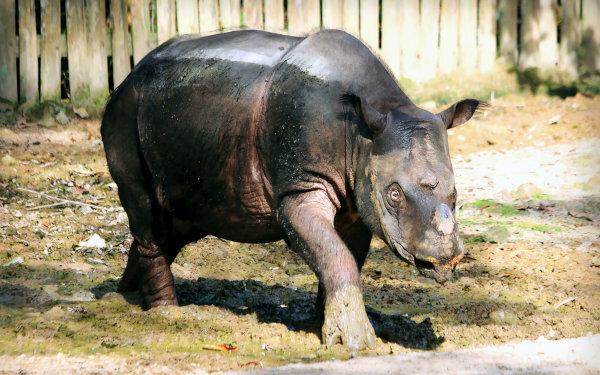rhinos they are mammalsherbivores found in Africa and Asia that have thick skin and horns very commercially targeted. The term rhinoceros is used to refer to five species distinct: white rhinoceros, black rhinoceros, Indian rhinoceros, Sumatran rhinoceros and Javan rhinoceros. Of the known species, three are classified as "critically endangered", which shows us the need to preserve these animals.
Read more: Difference between horns and horns
Classification of rhinos
Rhinoceros is a term used to refer to five species, which are included in four genera. They are: white rhinoceros (keratotherium simum), black rhino (Diceros bicorni), Indian rhinoceros (Rhinoceros unicornis), Sumatran rhino (Dicerorhinus sumatrensis) and java rhinoceros (Rhinoceros sonoicus). All rhinos share the following taxonomic categories:
Kingdom: animalia
Phylum: Chordata
Class: Mammalia
Order: Perissodactyla
Family: rhinocerotidae
Rhino characteristics

Rhinoceros is a term that refers to different species, however, analyzing this group of animals, it is possible to observe some characteristics common to all of them. Rhinoceros, in general, are animals that present large, heavy, broad body and short legs. Depending on the species, it is possible to observe the presence of one to two horns. Your skin is thick, assuming, in some species, the aspect of armor. The hair is sparse, the eyes are small and the ears are short. They have a tail with stiff bristles.
rhinos are animals territorialists, marking their territory with urine and feces. A curious fact is that the feces are organized in piles, which can reach up to one meter in height. Rhinoceros make furrows around these piles, using their horns to make them more visible. They are animals that live in a solitary way, except for mothers with offspring and mating pairs. They are usually found in regions where it is possible to have easy access to the source of Water. They can run at up to 45 km per hour.
Rhino Reproduction
Males reach sexual maturity between 7-10 years of age, while females become capable of reproduction around 4-6 years of age. THE female gestation lasts between 420-570 days. They give birth, usually, a puppy every two years. The cub accompanies its mother until the birth of the next one. Rhinoceros live an average of 50 years.
Read too: Lion - carnivorous mammal found naturally in Asia and Africa
Rhino species
White rhino
The white rhinos (keratotherium simum) occur in Africa, with most individuals found in five countries: South Africa, Namibia, Kenya, Botswana and Zimbabwe. According to the IUCN, in 2017, there were around 18,064 representatives in nature, and approximately 750 in 2008 around the world in captivity. This species stands out for being one of the largest terrestrial mammals, reaching around 3600 kg. Females are smaller than males.
White rhinos have two horns, which are unequal in size, the longer one reaching up to 1660 mm. The white rhinoceros has a light gray skin. These animals, in general, are not aggressive, but females with offspring tend to protect their offspring, showing, therefore, more aggressive behavior.
black rhinoceros

The black rhinos (Diceros bicorni) are found in different areas of Africa, being observed, for example, in Angola, Kenya, Mozambique, Namibia, South Africa, Tanzania and Zimbabwe. These animals reach about 1400 kg. They are usually gray in color, but may vary from yellowish brown to dark brown. They have two horns, the former being generally longer, with a size of about 128 cm. Black rhinos have a smaller head, shorter ears, and shorter horns than white rhinos.
Indian rhinoceros

The Indian Rhinoceros (Rhinoceros unicornis) is found in India and in the Nepal. According to information from the IUCN, in August 2018, the total population of Indian rhinos was estimated at 3588 individuals, 2939 of which were found in India. A striking feature of this species is the presence of a single horn, which is around 529 mm in size. The skin of this species is full of folds, which gives it an appearance of armor. They can weigh 2000 kg.
Sumatran rhinoceros

The Sumatran Rhinoceros (Dicerorhinus sumatrensis) is currently found in Indonesia, and, according to the IUCN, the total population is estimated at less than 80 individuals, making it one of the most threatened large mammal species on the planet.
It stands out for being the smallest among the living rhino species. It can reach 2000 kg. A striking feature of it is the presence of two deep skin folds, which surround the animal's body between the legs and trunk. The body color of these animals is usually dark gray or brown. They have two horns, the frontal being more visible.
Rhino of Java

The Javan Rhinoceros (Rhinoceros sonoicus) is currently found only in Indonesia, in a small isolated area of the country. Its horns are the smallest among the rhino species. Adult males have a horn about 25 cm long. The Java Rhinoceros body is gray in color. They weigh about 2000 kg.
Read too: Common hippopotamus – amphibious in habit, naturally found in Africa
Rhino feeding
rhinos are animals herbivores, that is, they feed on vegetables. These mammals feed mainly on grasses or branches. Their diet varies according to the species studied.
Why are rhinos threatened with extinction?
Rhinoceros are animals that have suffered and still suffer from the illegal hunting. The objective of hunters is, in most cases, to remove the horns, which are used to supply the illegal trade. These horns are used ornamentally and also in traditional medicine. In addition to hunting, rhinos suffer from loss of your habitat, climate changes, non-native diseases and even civil wars.
See the conservation status of the different species of rhinoceros in the table.
Rhino species |
Conservation status of the species, according to IUCN |
White rhino |
almost threatened |
black rhinoceros |
critically endangered |
Indian rhinoceros |
Vulnerable |
Sumatran rhinoceros |
critically endangered |
Rhino of Java |
critically endangered |
By Vanessa Sardinha dos Santos
Biology teacher

